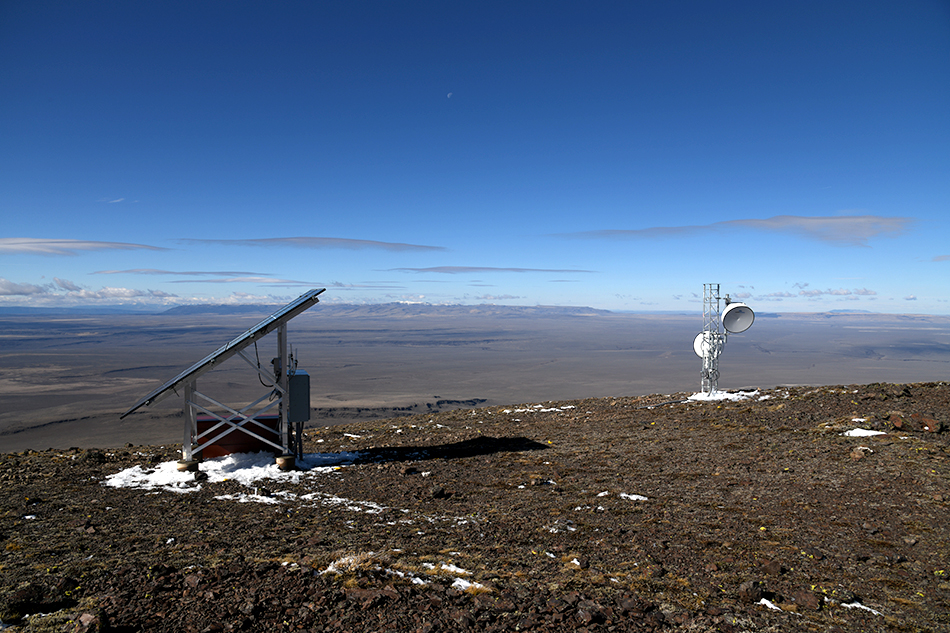Prevention and detection are key elements to reducing fires and the associated impacts to wildlife in the high desert. Thanks to our partnership with land managers and universities, a live camera atop Beatys Butte is part of local efforts.
Fire is a natural and important part of shrub-steppe ecosystems across the West. However, the spread of annual invasive grasses can drive more accelerated wildfire cycles and fragment wildlife habitat that sensitive species, such as greater sage-grouse, rely on. In some places, the presence of cheatgrass has reduced natural fire intervals from every 30-100 years to every 5-15 years. This creates an advantage for cheatgrass and other invasive weeds since sagebrush can’t recover as quickly.
One of things that makes the Hart Mountain – Sheldon region special is the fact that it has remained largely intact due to its remoteness and relative lack of development. The area is home to iconic wildlife, human artifacts and incredible vistas. The 7,918-foot summit of Beatys Butte, which is owned by Oregon Desert Land Trust and open to the public, is now contributing to fire response efforts in the region.
Fire season in the Pacific Northwest is generally May through October and mountaintop cameras provide vital information sources for fire managers and the public. Last November, fire detection cameras were installed on Beatys Butte and Fish Creek Rim by the Bureau of Land Management’s (BLM) Lakeview District, along with personnel from the University of Oregon and University of Nevada, Reno.
The new fire camera replaced a defunct repeater tower that was housed in an old refrigerator atop the Beatys Butte summit and was removed by ODLT volunteers in 2019. Along with a fire camera that recently went up on Bryant Mountain and another planned for nearby Acty Mountain, the collection of cameras will provide important coverage for fire monitoring efforts in the Hart-Sheldon region.
With more than 700 live cameras, the ALERTWildfire network provides state-of-the-art camera access for firefighters, first responders, and the public to spot and track fires. Fire managers can zoom, rotate 360 degrees, tilt, see multiple angles and review past footage. The video feed is open to the public at any hour, and includes recent time-lapse recordings.
The network evolved from a California youth project of the Forest Guard team to assist with local forest fires. Now, more than 150 firefighting personnel in seven states have cameras in their toolkits.
“When we get a report of a fire in an area covered by a detection camera, we’re able to turn the camera to wherever that location is. We can confirm the report and, if the observed threat of the fire is higher than what the response level dictates for that day, we can also adjust that response level from our dispatch centers,” explained Jeb Koons, an interagency fire staff officer.
Fire detection in remote areas of eastern Oregon is typically limited to a few residents, visitors or aviators passing by. Early discoveries of fires can result in more safe, effective, and efficient responses. Ultimately, this timely and accurate information can increase safety for firefighters, local communities, and visitors.
Early fire detection can also decrease impacts on sensitive landscapes. The greater Hart Mountain – Sheldon region is recognized as one of the most important areas in the nation for the long-term survival of two iconic western species: the greater sage-grouse and the pronghorn antelope, North America’s fastest land animal. A shared concern for the effect of wildfire on high desert landscapes and wildlife habitats led us to work with BLM and ALERTWildfire partners.
“Overall, this will provide an early detection and rapid response to fire in key sage-grouse areas like Beatys Butte,” said Todd Forbes. “We would like to thank the private landowners that have let us install these cameras on their private lands at Beatys Butte and Acty Mountain in an effort to help maintain Oregon’s remaining sagebrush habitats.”
Reporting fires
Most fires people spot have already been reported on ALERTWildfire’s website and a response is underway. But not always… here are tips to see if you’ve found unreported fires.
- BLM shares info on fire management and preventing wildfires on public lands.
Fire detection camera photos provided by BLM Lakeview District








